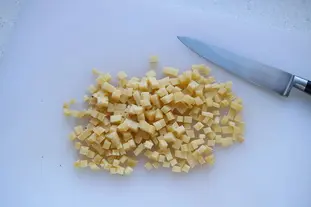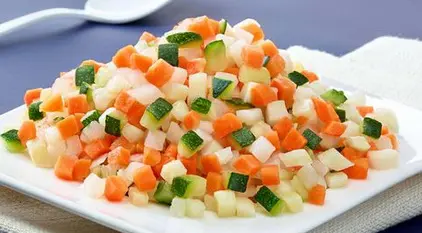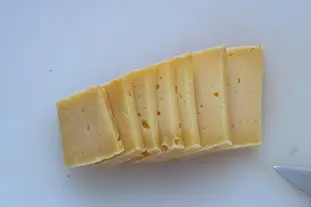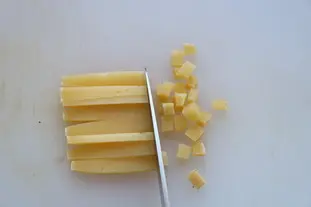Small, regular pieces

When we cook, bake or pastry, we often have to cut food into small pieces, often cubes, to incorporate them into a recipe or preparation.
How do you get regular pieces fairly quickly?
How do you get regular pieces fairly quickly?
11 K 4.5/5 (17 reviews)
Keywords for this post:TechniqueCuttingPiecesKnifeSizeLast modified on: November 28th 2020
Small, regular pieces

This need for small, regular pieces often arises when you have to cut up a whole heap of food, usually raw, and dice it most of the time. Note in passing that very small pieces = brunoise, larger pieces = mirepoix, in the vocabulary of cooks.
So it happens a lot, and if you're not too comfortable, you'll intuitively cut a first large piece of the food in question, then cut it into smaller pieces, start again, and so on.
This works, of course, but it takes a long time, and above all you'll be very irregular.
Is there a trick to this?
Yes, yes, well actually it's more a method, a way of doing things, a "taille" as the cooks say.
Take a look at how, for example, to obtain small cubes of cheese (of course, this applies to just about anything else).
 1) Start by slicing or shredding everything you've planned, aiming for the thickness of the slices, the size of the dice you're aiming for.
1) Start by slicing or shredding everything you've planned, aiming for the thickness of the slices, the size of the dice you're aiming for.
 2) Stack the slices, then cut them into sticks, using the same size criteria as above.
2) Stack the slices, then cut them into sticks, using the same size criteria as above.
 3) Finally, cut the sticks (in groups for faster processing) into small cubes.
3) Finally, cut the sticks (in groups for faster processing) into small cubes.
 That's it, by proceeding in this way, you'll get the hang of it, and you'll be up and running in no time, especially once you've had a bit of practice.
That's it, by proceeding in this way, you'll get the hang of it, and you'll be up and running in no time, especially once you've had a bit of practice.
You can do this for just about any food.
Tosum up: when you've got dicing to do, do strips, then sticks, then dice. That's the secret of consistency and speed.
Lasts posts
Butter vs. grease
We often read in a recipe where a pastry is put into a mould that, just before pouring, the mould should be buttered or greased. But what's the difference between these 2 terms?December 1st 20251,0505
Getting out of the fridge early
Very often when you're cooking, you need to take food or preparations out of the fridge, to use them in the recipe in progress. There's nothing tricky about this: you just take them out of the fridge and use them, usually immediately, in the recipe. But is this really a good method?November 24th 20251,1535
Who's making the croissants?
When you look at a bakery from the outside, you naturally think that in the bakery, the bakers make the bread, and in the laboratory, the pastry chefs make the cakes. It's very often like that, with each of these professions having quite different ways of working, but sometimes there's also one...November 23th 20251,046
Oven height
When we put a dish or cake in the oven, we naturally tend to put it on the middle shelf, and that's what we usually do. But in some cases, this position and height can be a little tricky, so let's find out why.October 8th 20252,8275
The importance of sieving
In recipes that use a fine powder (flour, powdered sugar, etc.), you'll often see the advice to sift before using it. To sift is to pass the powder in question through a sieve (a very fine strainer) before incorporating it into your recipe. It's often advice, but is it really useful?September 3rd 20257,5703
Other pages you may also like
What is the difference between bakery and patisserie?
This is a question that you may well have asked yourself and which I will attempt to answer. In France the two trades of "boulangerie" (bakery) and "pâtisserie" (patisserie and confectionery) have always been quite distinct, but where exactly do the boundaries lie? .February 7th 2017134 K 14.1
Candied fruits: don't get ripped off
Do you like candied fruit? You might like to nibble a handful or add it to a recipe, like a classic fruit cake or delicious Italian specialities like panettone or sicilian epiphany pie.June 21th 201767 K 24.2
The so-called "nervous" meats
You've probably heard this before, we're talking about "nervous" meat, or meat with nerves, to describe what is indicated by the blue arrow on the left. This is a piece of beef, and what we call a nerve is not a nerve, it is in fact collagen (chemists sometimes call it a "collagen sink"), a...April 16th 202137 K4.5
No need to boil gelatin
Gelatin is a magical ingredient for making light, creamy, structured desserts, yet it's often misused in the kitchen. A common mistake in some recipes is the idea that it needs to be boiled for it to work properly, but this is a mistake indeed: gelatin melts at a much lower temperature, around...November 21th 20248,3095
A few tips for effective kneading at home
When you have to knead dough for bread or some other recipe, you may well use a food processor or the type of machine known as a stand mixer. The best-known brands are Kenwood and KitchenAid. They are useful tools, but here are a few tips to help you get the best out of them.June 23th 2021284 K 23.8
Post a comment or question
Follow this page
If you are interested in this page, you can "follow" it, by entering your email address here. You will then receive a notification immediately each time the page is modified or a new comment is added. Please note that you will need to confirm this following.
Note: We'll never share your e-mail address with anyone else.
Alternatively: you can subscribe to the mailing list of cooling-ez.com , you will receive a e-mail for each new recipe published on the site.









